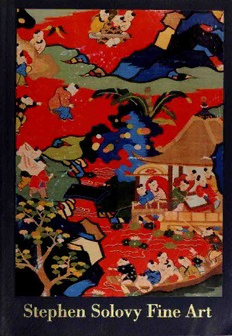
Splendors of Chinese Art PDF
Preview Splendors of Chinese Art
•-•• ». Stephen Solovy Fine Art t > H ^^H ^H Egg -v/.-V ^--^ H 1 I *«ra • • 1 saw? v* I Spa S£ I >J*m XV4 v 1 Stephen Solovy Fine Art Splendors of Chinese Art 980 North MichiganAvenue 13th Floor Chicago, Illinois6061 Telephone: 312.664-4860 Facsimile: 312.664-6726 This catalogue would not have been possible without the invaluable assistance of Dr. Francis Li, whose great knowledge and tireless support have guided me in mydiscovery of Chinese art. Dr. Li's magnificent generosity is further evidenced in the Chinese translations which he provided forthis catalogue. am indebted to the kindness and erudition of Fan Dongqing, of the Shanghai I Museum, who has illuminated my understanding and appreciation of the Spring and Autumn period gold-inlaid bronze stem-cup (cat. no. 8). I would also like to thank Dawn Odell for hersignificant contributions in cataloguing and research. Photography: Patrick O'Neill Catalogue Cover Design: Use Krause Printed in the U.S.A. © 1996 Stephen Solovy Fine Art. Chicago This catalogue is dedicated to Mary Kohl from whom inherited I my eye and appreciation for the beautiful. Illustrated(detail)andonpage23 8 Extremely Rare Gold Inlaid Bronze Stem-Cup EasternZhou Dynasty, SpringandAutumn Period (770-476 B.C.) Splendors of Chinese Art INTRODUCTION It is with great pleasure and excitementthat I present my gallery's inaugural exhibition of Chinese art, an event which celebrates our new location in the One Magnificent Mile building. inviteyou tojoin with me in this adventurous quest back intothe depths of I time. Chinese art embodies an inherently unique sensibility. Ifyou look closely atan archaic bronzevessel ora Han dynasty potteryfigure, you will immediately recognize their raw primordial powerand abstracted form-qualities which constitute ourWestern definition of 'modern'. The works offered for sale in this exhibition reflect ourefforts to maintain the highest standards of qualityand connoisseurship. Before considering a work for acquisition, we evaluated its rarity and condition, asking ourselves whether it was the very best example of its kind. Peruse this catalogue and discoverthe Warring States bronze figure ofa tapir standing majestically in a position of repose. This enigmatically profound creation ofthe fourth century BC could have leaped offthe canvas of a Magritte painting. Examine the dynamic composition of 'Boys at Play', the 17th century woven silk tapestry, and you will be struck bythis Ming artist's prefiguring of Cezanne, as he conveys a rocky landscape through the lyrical interplay of intersecting geometric planes. You could easily mistake the pair of black Neolithic goblets -stunning in their reduction ofform to its purest essence — as a striking example of modern design. You may also be humbled when you contemplate the sophistication ofthe Longshan culture which had the refinement oftaste to create these magnificent goblets over4,500years ago! Asyou explore the myriad intricacies of Chinese art, yourconception oftime, and our place within the continuum of man's evolution, will be forever altered. Coming from a culture which measures time and cultural evolutions in decades, it is a great leap to step back to the art ofthe Chinese civilization whose interstices are measured in millennia. Stephen Kohl Solovy CHRONOLOGY B.C. A.D. Neolithic period Circa5500 - 1700 Xia dynasty Circa2100 - 1600 Shang dynasty Crca 1600 - 1045 Western Zhou dynasty 1100 - 771 Eastern Zhou dynasty 770 - 256 Spring and Autumn period 770 - 476 Warring States period 475 - 221 Han dynasty 206 - 220 Western Han 206 - 9 Eastern Han 25 - 220 The Six Dynasties 220 - 581 Northern and Southern dynasties Sui dynasty 581 - 618 Tang dynasty 618 - 906 Five Dynasties 907 - 960 Liao dynasty 907 - 1125 Song dynasty 960 - 1279 Northern Song 960 - 1127 Southern Song 1127 - 1279 Jin dynasty 1115 - 1234 Yuan dynasty 1279 - 1368 Ming dynasty 1368 - 1644 Qing dynasty 1644 - 1911 1 A Fine Pair of Eggshell Black Earthenware Goblets Late Neolithic Period, Longshan Culture (circa2700-2100 BO Height: 9.25 in (23.5 cm) and 7.75 in (19.6 cm) These black earthenware goblets are remnants of the long-vanished Neolithic Longshan culture of Shandong Province. Little is known ofthe people who produced these objects beyond their ability to create pottery vessels of a rare delicacy and elegance. Made from an exceptionallyfine-grained clay, the goblets were thrown on the wheel in individual pieces which were then luted together before firing. This potting method and the overall quality of the clay allowed forthe astonishing thinness ofthe gobletwalls, in places merely one tothree millimeters thick. Burnished to a glossyfinish, the cups are simply decorated with fine horizontal score marks around the bowljust beneath the flaring lip, and with small incisions in the bulb ofthe stem- refinements which do not detractfrom the simple beauty ofthe goblets' angular, elongated form. Similar Examples: Margaret Medley, The Chinese Potter, Oxford, 1976, fig. 12, p. 25. William Willets, Foundations ofChineseArt, London, 1965, fig. 17, p. 39.
